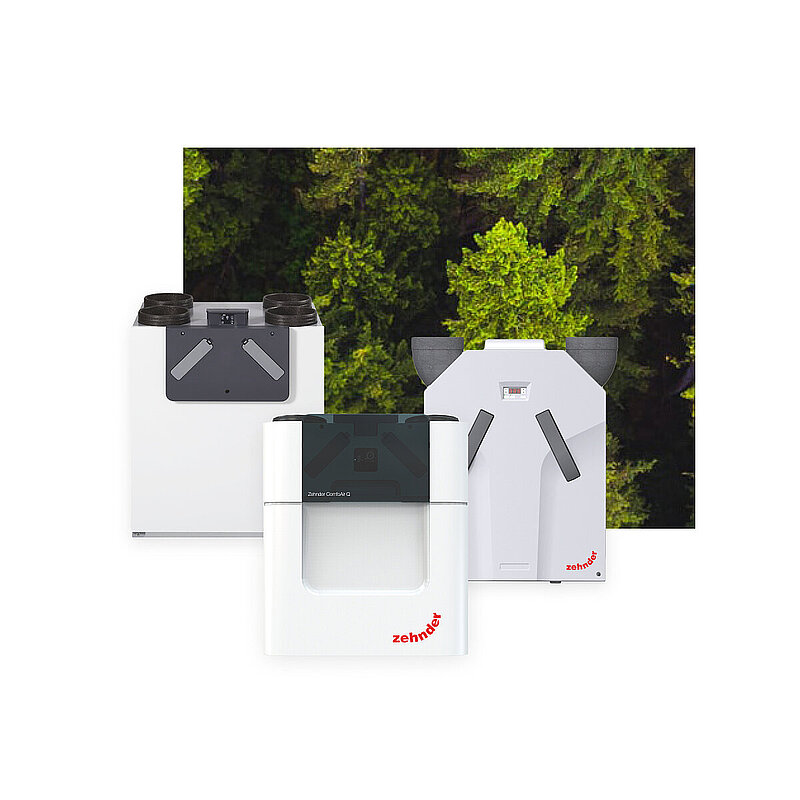
Ventilation with heat recovery
With a heat recovery unit from Zehnder, you create a comfortable and healthy climate in your home.
A central CHW (Chillled-water-system) system ventilates the entire house from one point in the house. Via the air distribution system, air is supplied and removed at the right place. So there is always sufficient fresh air everywhere in the house. Here, the heat or cold already present in the house is reused. So no energy is lost.
Discover all the benefits of ventilation with heat recovery (WTW) for yourself.
Balance ventilation continuously supplies fresh, clean air. And it filters before it enters your home and removes polluted, moist air. Thanks to this healthy indoor climate you will feel more energetic than ever!
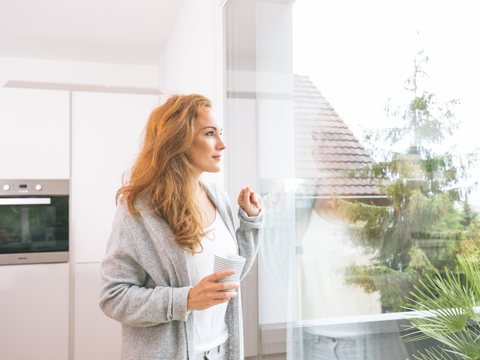
Opening a window for fresh air is no longer necessary. This means you enjoy extra comfort: healthy air and a safe feeling, but no problems with noise, insects or drafts

Heat recovery influences the temperature of the supply air with the heat or cold from the house. Up to 95% of the energy is reused. So you don't have to use your heating or air conditioning as much!

Balanced ventilation protects buildings against excessive humidity. This makes the installation of a Zehnder heat recovery unit an investment in the future value of your home.

The heat recovery unit ensures that the temperature of the outgoing air is used to influence the temperature of the incoming air. This happens in the heat exchanger. About 95% of the energy can be reused. In addition, the humidity can be maintained using an enthalpy exchanger. Your home stays pleasantly warm in winter and nice and cool in summer.
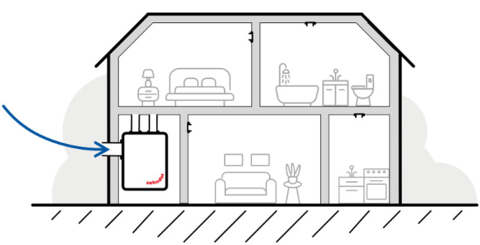
Do you already have a comfortable room ventilation system from Zehnder and would like to add additional moisture recovery? You can retrofit the Zehnder enthalpy exchanger for additional moisture recovery in your comfortable room ventilation system at any time.
Low maintenance and washable with water
The only washable enthalpy exchanger on the market: the robust and patented polymer membrane makes the Zehnder enthalpy exchanger quick and easy to maintain and at the same time extends its service life.

With original Zehnder filters, your ventilation system keeps out fine dust, pollen, soot particles and even bacteria. Filtering the outside air before it enters the ventilation unit extends the lifespan of the unit. Replace the air filters of your heat recovery unit once every six months. This way the system remains quiet and energy efficient. And the indoor climate is healthy.
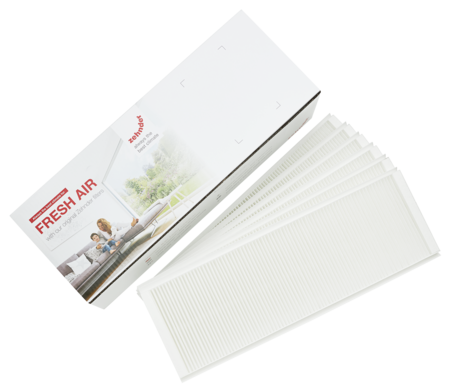
A comfortable climate in your home all year round? Then expand your ComfoAir Q ventilation unit with the golden combination: Zehnder ComfoClime and Zehnder ThermalShield.
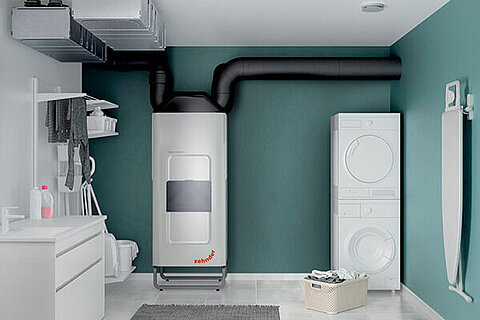
Ventilation with heat recovery ensures that used air goes outside and clean fresh air enters your home. This is also called balanced ventilation. This balanced ventilation is economical, meaning that almost no energy is lost.
The heat recovery unit ensures that the temperature of the outgoing air is used to influence the temperature of the incoming air. This happens in the heat exchanger. About 95% of the energy can be reused. In addition, the humidity can be maintained using an enthalpy exchanger. Your home stays pleasantly warm in winter and nice and cool in summer.
Ventilation with heat recovery is a healthy and comfortable way of ventilation. It ensures that no polluted air remains in the home and it maintains the temperature and moisture content. In addition, it ensures significant savings on your energy bill.
Yes, a ventilation system with heat recovery automatically makes a 'ClimateSwitch': the temperature of the outgoing air is used to influence the temperature of the incoming air. In addition, the ventilation system has a bypass function that allows use of summer night cooling. This way you can keep your home cool in the summer and you don't have to use air conditioning as much or not at all
In addition to these passive ways of cooling, there are also a number of active cooling solutions that can be connected to the ventilation system.
A central heat recovery system ventilates the entire home. Fresh air is blown into the home via the air supply valves. Used air is extracted again via the air exhaust valves.
There are decentralized heat recovery units for heat recovery from individual rooms or smaller residential units. These heat recovery units do not have an air distribution system, but are mounted in the outer wall of the room to be ventilated. This makes it possible to quickly achieve a healthy and comfortable indoor climate without the need for major interventions in the home.
A suitable heat recovery ventilation system is available for every home. For a large home you logically need a heat recovery ventilation system with a larger capacity than for a one-room apartment. By making a (ventilation) balance calculation, you can determine exactly what the capacity of the heat recovery ventilation system must be for each home to comply with the local Building Decree. Also determining is whether the system is used for renovation or new construction.
A central heat recovery ventilation system consists of several components. The central heart of a heat recovery ventilation system is the heat recovery unit. A complete air distribution system is connected to this, which brings the air to and from the different rooms in the house. This air distribution system consists of air hoses, silencers, air distribution boxes and air valves.
Yes, with ventilation with heat recovery, windows and doors of the home can simply be opened. This does not affect the operation of the ventilation system. However, more cold air will enter the home in winter, which means more energy is needed to heat this cold air. The same applies in reverse for warm air in summer.
It is best to replace the filters of your heat recovery unit at least twice a year. This keeps the air healthy, keeps the ventilation system quiet and extends the lifespan of your device.
Do you live in a new-build home? Then it is wise to replace the air filters more often in the first year. There is often still building material present in the home. The filters prevent construction dust from entering the ventilation unit and will therefore become contaminated more quickly. It is therefore wise to replace the filters of the ventilation unit more regularly during this period.
Depending on the type of heat recovery system you have, you operate the ventilation manually or everything happens completely automatically. Control options include switches and CO2 sensors.
To keep your heat recovery unit in top condition, it is recommended that you have it maintained at least once every two years by an installer specialized in ventilation. This means the ventilation unit lasts longer and the capacity and energy efficiency of the system remains optimal.
You can replace the filters of your unit yourself. You keep the air in your home healthy by replacing the filters at least twice a year. This ensures that the ventilation system remains quiet and extends the lifespan of the device. You can also clean the valves in the wall or on the ceiling.
You can easily remove dust and other dirt from the valves with soapy water and dishwashing liquid. You can carefully remove them from the wall or ceiling. Make sure that you put the valves back in the right place. The valves are set differently in height.
The question 'How long does a heat recovery unit last?' can be compared to the question 'How long does a car last?'. A question where the answer depends on all kinds of factors. An indication is that a ventilation unit with heat recovery has a technical lifespan of 15 years. This does not mean that a heat recovery unit must be replaced after 15 years. Defects can often be resolved by replacing individual parts.